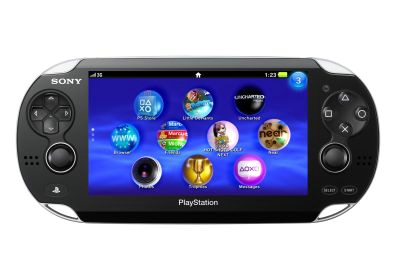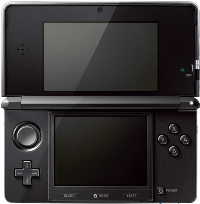While thinking about Johan Huizinga’s definition of play in connection with how I view videogames, I began to think about my long history with handheld gaming. His specific mention that play crates another world of sorts within the realm of whatever is being played – the game, played with a bat and ball or with a controller may be played in our world but it creates a world with its own rules and parameters independent of the real world. Usually that space is confined to a baseball diamond or a TV set, but with handhelds, I was always able to bring those new worlds with me, immersing myself in them in my house, on planes, or waiting in line. Some of my favorite gaming moments, as a result, have been the satisfaction I have felt beating games or scoring thousands of lines in Tetris on my GBA or DS.
Yet, it has been a few years since a major handheld release has occurred, and my interest in my DS has waned over that time. Sony dropped the original PSP in 2005 in hopes of combating Nintendo’s DS. While the DS was a runaway success, the PSP only did modestly in comparison, though for any company to make a dent in Nintendo’s handheld dominance is commendable. So Sony hopes to do so even further when they release the codenamed “Next Generation Portable” to the masses.
While we have to wait until an undisclosed date at the end of this year for that, Nintendo’s handheld, the 3DS, is only a mere two months away, hitting shelves at $250 on March 27th. I’m glad to see new hardware and the promise of new games, but already both companies seem to be making mistakes that may make this race up for grabs.
The NGP, while having a terrible codename, is nothing short of a powerhouse. With games looking near-PS3 quality already, a touchpad and touch screen, dual analog sticks, and promise of a very connected user-interface, the NGP/PSP2 is a promising system. Games announced already include original entries in the Uncharted, Resistance, Call of Duty, and LittleBigPlanet series along with original titles promising to take advantage of the system’s extra features. This all sounds great, but we are missing key details that could make or break the NGP.
First of all, we don’t even have a name to call it. NGP is a horrible moniker, there seems to be a collective agreement on that, but to reveal what is clearly a big part of their strategy going forward, I would have liked Sony to afford us the chance to call it by its real name. Secondly, the absence of an announced price point worries me. This system won’t be commercially viable if it goes above $300, but with the astounding tech and Sony’s history, a $400 tag unfortunately is not out of the question. The final major sticking point for me is the games. New games in all of the mentioned franchises are great and welcome, but if the platform can’t create its own exclusives and have a steady stream of broadly and hardcore appealing titles, it may suffer the same fate as the PSP. The DS managed to appeal to everyone because of its quality game variety and frequency, which the PSP floundered on with only a few truly standout titles a year.

My dream feature, but one I think is essential to the NGP’s survival, is something Sony hinted at may be possible – the ability to transfer a game session from one’s PS3 and take it with them on the go. I would love (and Kotaku wrote an article essentially detailing this) if a game could be bought that can be downloaded on both systems and allow saves transferred between them. This could be a major selling point. I know personally that I would love my marathon game sessions of Uncharted on my PS3 to be given a bit of extra time on a train or bus ride that would have otherwise stopped my playthrough.
The 3DS, while not having the odds as greatly stacked against it, in my mind still has issues. Coincidentally, they are broadly the same as the NGP’s, though looking at them in more specificity they are unique. The name is one such similar problem. Anyone who has followed coverage of the 3DS will know that the system is a clear advancement aside from the 3D. It is much more powerful, and will allow for closer to Wii quality games then we’ve seen from a Nintendo handheld.
Yet, the DS still tethers it to the previous line of handhelds, and what is to stop a parent from buying one of those older systems thinking they are equivalent? This is especially problematic when factoring in the next issue – the price. When a parent sees two similarly titled handhelds at the store, one for $150 or the 3DS for $250, the choice is clear for a parent in these economic times. The 3DS may be worth the price of a launch Wii, but there is a stigma that a handheld, because of its smaller size, should have a smaller price.

Lastly, the game lineup once again presents an issue. Nintendo has detailed a launch window for the US, a few months time in which games will come out, but the day 1 lineup is still a mystery. This needs to be cleared up, and there needs to be a system seller. Two such games, Kid Icraus and the remake of The Legend of Zelda: The Ocarina of Time, seemingly won’t make launch day, and the rest of the lineup is somewhat lackluster. With such a storied history to pick from on the DS, we need to see a constant output of new iterations of these hits to keep the Nintendo faithful and the general public pleased.
It’s an exciting year for handheld gamers, with two new and promising handhelds about to come out of the gates. I hope both systems can achieve, and bring the wonder of portable gaming and the worlds you can fit in your pocket to a whole new generation, but I’m worried by the decisions made so far by both Nintendo and Sony. Somewhat of a course correction is in order, but I have faith in both companies that they can create worlds I will want to bring with me wherever I go, even to escape into them for only a moment. It will be an interesting race to watch, and will hopefully foster a great generation of handheld games that will appeal to all types of gamers.
No comments:
Post a Comment